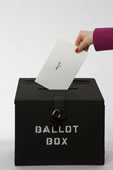Suddenly, solar power is hot.
And no, I don't mean the special oil heated by fields of mirrors in the Mojave desert (although that's hot too).
No, what I mean is that perhaps Malcolm Gladwell's famous "tipping point" may have been reached.
Prodded, no doubt, by the constant pleas on this blog and the mighty influence of the Thin Green Line's 13 regular readers, both the House and Senate this month passed by large margins, legislation that will extend tax breaks for investment in renewable energy sources like wind and solar power.
Of course, this being Washington, the bills are different so the two houses of Congress have to negotiate something they can both agree on, never a sure thing in this day and age when everyone talks the bi-partisanship talk, but almost universally fails to walk the walk.
According to
this Sept. 26 article in The New York Times, "the tax credit would increase domestic investment in the solar industry by $232 billion by 2016 and generate 440,000 jobs, many in manufacturing, construction and engineering."
But now that we have Washington on board (we hope) with taking advantage of the most free, most renewable, most dependable energy source in the solar system, we turn around to find our fellow tree huggers raising a fuss.
What am I talking about?
Well according to
this Sept. 23 article in the Times, environmentalists in the southern California desert are protesting massive solar projects planned for flat land where the sun shines 364 days a year.
Their problem? The Mojave ground squirrel, the desert tortoise and the burrowing owl. (Why is it always an owl?)
Time for a little hypocrisy.
Yes, this blog supports protecting old-growth forests from logging for the spotted owl. Yes, this blog, with some reservations, believes hydro-power (another green source) needs to take the needs of migrating fish into account.
So do we need to worry about the squirrel, the tortoise and the owl too? Aristotle would argue that we cannot support the preservation of one habitat and support the disturbance of another only because it's hot and dry and only crazy people would want to live there. (Sorry mom).
But Aristotle, hemlock and all, lived in a world of theoretical absolutes and we live in a world where even crazier people live in an even hotter desert half a world away and sometimes you have to choose the lesser evil.
Condemn me if you will green purists, but I'm afraid I have to come down on the side of massive solar power installations on this one. And for justification, I will turn to a justification so often over-used by the administration I love to criticize.
The answer, folks, is national security. This country can simply no longer afford to depend on a fossil fuel technology. When Barack Obama talks about building a new energy infrastructure in ten years, he is talking about a necessity, not a frill.
If you doubt me, ask the Pentagon.
Meanwhile, it's not just in California's deserts that such projects are being proposed.
According to
this Sept. 24 article in The Mercury (written by yours truly), one use being championed for the former OxyChem site in Lower Pottsgrove is a solar power park.
The proposal comes within the framework of a joint project of the U.S. Environmental Protection Agency and the U.S. Dept. of Energy. It is a push to put alternative energy projects on former industrial sites, often called "brownfields," on which it is often difficult to attract redevelopment. Talk about a win-win.
(Click
here to learn more about this program.)
Meanwhile in the win-win department, and also to show that not all Californians lean toward lunacy, I point to yet another article in the Times which is cause for hope.
In the far-left bastion of Berkeley, the city council is doing something innovative.
As
this Sept. 17 article illustrates, the city is starting a low-interest loan program to encourage the installation of solar power in its homes.
"The loans, which are likely to total up to $22,000 apiece, would be paid off over 20 years as part of the owners’ property-tax bills," according to the Times. This will make solar power more accessible to people who cannot afford the up-front costs and thus cannot benefit from the usual tax-break incentive government favors.
Already cities from San Francisco to Annapolis, Md., and Seattle, to Cambridge, Mass., are calling to get the details.
Here in Pottstown however, we're actually trying to limit solar power installations under the rationale that they could ruin the lines of our historic architecture.
According to
this Sept. 13 article in The Mercury (also written by yours truly), the Pottstown Planning Commission has proposed changes to the zoning law that would regulate how solar panels could be installed. Borough Council has agreed to hold a public hearing on the subject, but no date has yet been set.
This may once again be an occasion for hypocrisy as I am not sure, despite my love for old homes (I live in a house built in 1916 after all), whether its wise to deny energy-efficiency to those whose homes are least likely to have it.
We may even have to get the police may have to get involved.
For it seems that solar panels are popular not only with city councils and other law-makers and law-abiding citizens. According to this
Sept. 23 article in the Times, solar panels are now in such demand that people are stealing them!
"Police departments in California — the biggest market for
solar power, with more than 33,000 installations — are seeing a rash of such burglaries, though nobody compiles overall statistics," according to the Times.
"Investigators do not believe the thieves are acting out of concern for their carbon footprints. Rather, authorities assume that many panels make their way to unwitting homeowners, sometimes via the Internet," the paper reported.
So (wait for it....) when I said solar power is "hot," I meant it in more ways than one!
(Oh come on, don't groan. That one was sweet!)
Labels: Berkeley, California, EPA, New York Times, OxyChem, Pottstown, solar power, The Mercury, U.S. Dept. of Energy, zoning


 selecting candidates who have "pro-green" policies on Tuesday, voters across the country (including here in Pennsylvania) will also be able to vote on those green policies themselves.
selecting candidates who have "pro-green" policies on Tuesday, voters across the country (including here in Pennsylvania) will also be able to vote on those green policies themselves.